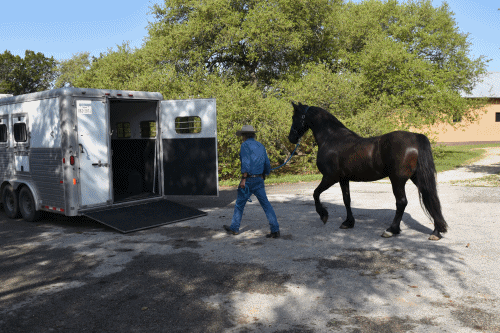
Reign gets in with ease, but it was not always so.
This topic is one of the most difficult of all horse topics.
Horses are:
1. Claustrophobic. Afraid of small spaces.
2. Without good vision as light changes from sunlight to shadow. Afraid of dark spaces.
3. Afraid of loud noises or different footing.
4. Unfamiliar with how to manage their feet stepping up and stepping down.
If we can get rid of any one of these, so much the better.
Some horses are just new to loading, others are pros who are “playing” their owners, others have had bad experiences and have some PTSD to overcome. Regardless of which type of horse you are dealing with, the first step is to gently introduce the horse to the trailer and all of its strange sensations so that he can find the sweet spot inside the trailer. Most horses are leary of a first encounter with anything strange. It goes without saying that you must be sure to allow time for him to approach, view, smell, stretch to investigate, and back away if uncomfortable. Approach, retreat, approach, retreat. Approach, retreat.
Also remember that horses’ eyes are different than our. They cannot adjust from the full sun of the outdoors to the dark shade of the interior of the trailer. It takes a lot of trust to enter a black box, so introduction and time are required.
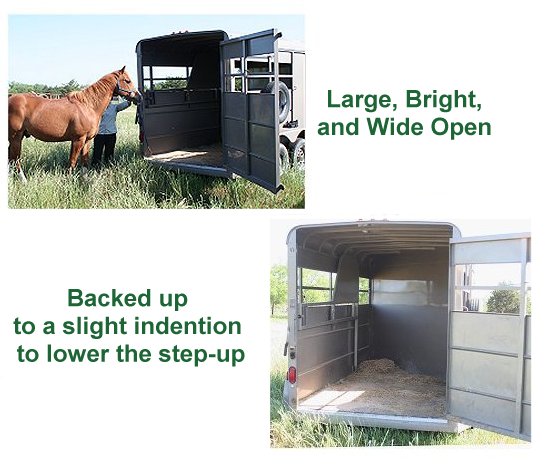
There is a difference between a horse that is new to this procedure and one that is already giving you trouble loading. A really trailer-sour horse can present a myriad of problems depending on his unique set of objections and his previous success at objecting and getting away with it. The amount of danger he presents to his handler is also different with each horse. This article assumes you have a reasonably trained horse – not a still-wild mustang.
With the average horse, the procedure is usually pretty straight forward . The first step is to gently introduce him to the trailer. Walk around it. Ask him to look AT the trailer, then look INTO the trailer. If this is acceptible, you walk up the ramp leading him and anticipate that he will follow you and put at least one foot onto the ramp or step. If he is hesitant but not frantic, turn around, bend your body small and invite him to step one more step by pulling gently on the lead as you talk in a relaxed voice. If he balks backward at any of these maneuvers, hold tight to the lead (if you can) until he relaxes, then release the pressure and let him stand and think a minute. Repeat. Repeat until he is taking first one step and then two steps onto the ramp.
If he is more dramatic and flys backward, go with him. Allow him to get to his safe distance and relax. Approach the trailer again. Try to get at least a foot onto the ramp. If he flys back again, go with him again.
Accept baby steps: one foot on the ramp, two feet on the ramp, two feet and stand there, three feet, until he is in. Then stand and talk for a minute or two. See this video for a very easy introduction. Most first loads take 15-20 minutes, so don’t be discouraged if it isn’t as fast as this colt. He was a surprise.
Your horse already has a problem loading?
OK. So all of the methods below have worked for me on one horse or another. Some will work better than others for you. Some take more effort and manipulation of the surroundings. Some just take more training. Self-loading using the line-lunging technique and the Squeeze is by far the most showy method. Your friends will cheer your routine.
Get Ready
Find the largest trailer you can find. If you have a choice between a closed-in trailer or a stock trailer, take a stock trailer. It is more open. If you use a closed-in trailer, open the front viewing window to get as much light as possible.
If you can first use a trailer with a walk-up ramp. Great. (The horse in the animation is using a large trailer with a padded walk-up that keeps his footing quiet and firm, avoids the step-up, and has plenty of room inside, although it is dark). If you don’t have that luxury, a step-up will work. It is just more difficult. If it is a small two-horse, take out the middle separator if you can.
Do you have a place on the property where you can back up into a slight “ditch” in the ground that lowers the trailer wheels and leaves the back nearly on the ground? (we have dug one just for this purpose). You can start there. It eliminates the “step-up”.
He Balks at the Entrance or Throws Himself Backward.
This is the most frequent reaction a horse exhibits when asked to load. Some do it out of fear of a new experience. Some have loaded before and do it because they are ornery.
The Backward Approach. It’s Not What You Think.
I twice loaded Stella the horse into the trailer that Reign travels in. On the third attempt, she refused to go in. I could get her to lunge outside the ramp. I got her to lunge right OVER the ramp: Clomp, clomp. (The sound of her feet on the ramp was no issue at all.) I got her to put her two front feet on the ramp where she could put her head in, but that was as far as she was going. If I pulled on her halter to “drag” her in, she bolted backward, dragging me out instead. She had all of the leverage.
Well, I had had about enough of that. I knew she was capable of going in. She just didn’t want to.
Coincidentally a friend, a natural horse training cowboy, was going to visit the ranch on that day. This would be a perfect opportunity to get some movie footage of an expert’s approach to this naughty horse.
Jamon arrived, did a little assessment of Stella’s personality, and went right to work.
He and Stella approached the trailer, he walked into it as if she would just follow him, and got the same reaction I got. He allowed her to look, think, and make a decision, but her decision was to fly backward to a good distance and stand – the winner in the contest.
The next time she had her feet on the ramp but bolted backward rather than move forward, he went with her as fast as she backed up. But instead of stopping when she felt comfortable, he forced her to back up at lightening speed around the pasture. Back up. Backup, Back up. Then he stopped and quietly went back to the trailer ramp. “Will you come in?”
The answer was another backward bolt. They both went flying backward again, he pushing her faster than she liked and going further than she wanted to go. He made her back up quite a distance. Then another quiet trip back to the trailer ramp.
It took four backward trips around the pasture before she decided that IN was more relaxing than OUT. Jamon made the approach and she walked in like she had been doing it for days. She didn’t look like the same horse. She stood inside the trailer while Jamon talked to her, caressed her head and neck, let her realize what a nice experience she could have. Then he slowly (giving her time to look behind her) backed her out of the trailer one foot at a time. Take one step back. Stop. Come back in. Stop. Take two steps back. Stop. Come back in. Starting and stopping several times to show Stella that flying backward out of the trailer is not the way to exit. At last they were out and relaxed.
Three or four more easy entries and controlled exits later, Stella was a champion loader.
Subsequently, in the same day, Jamon loaded her in an open stock trailer with a high step. Once she realized what the alternative was, she was game for any trailer. (see the video below of her unloading the stock trailer in a controlled exit)
Unfortunately, I became so engrossed in watching Jamon’s magic that I forgot to film the routine. (Hopefully next visit he will demonstrate for the camera).
Backing Out
How a horse UN-loads is almost as important as how he loads. I prefer that a horse back out of trailer like a Lady or Gentleman. Turning around in a tight space could be dangerous, although many people with large trailers such as the one that Waters loaded in above allow their horses to come out face first.
A horse can see nearly 360 degrees around their body. Read about their vision here. When backing out, it is important that a horse be given time to look behind him and understand where he is going. Watch Jamon teach Stella how to comfortably back out of the ramp trailer first, then his high-step trailer.
Lunge-Loading: Similar to the Backup.
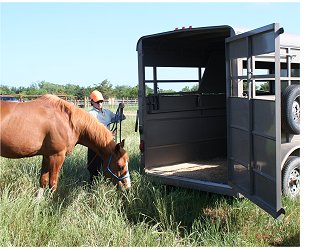 Like the back-up technique, this procedure takes the philosophy that inside the trailer is more desirable than outside because Outside he must work. Inside he can rest. (This horse is standing in knee-deep, luscious rye grass and is allowed to relax and eat. How desirable does the trailer look compared to his surroundings?)
Like the back-up technique, this procedure takes the philosophy that inside the trailer is more desirable than outside because Outside he must work. Inside he can rest. (This horse is standing in knee-deep, luscious rye grass and is allowed to relax and eat. How desirable does the trailer look compared to his surroundings?)Park the trailer where there are fewer desirable distractions.
Your horse should already be good at line-lunging (lunging in hand). Take him to the rear of the closed trailer. There is much less threat from a closed trailer. Start lunging in a small circle that takes him right past the trailer: the rear and the sides. Let him investigate, smell and study the trailer if he shows a desire to do so, but generally keep his feet moving. His feet are connected to his brain while you move him from side to side. You are controlling his movement as he makes pass after pass near the trailer. He will begin to forget the trailer, as he concentrates on your requests to move his feet. See more description of Introducing Obstacles such as the trailer here.
When you feel that he is tiring of this routine, open the trailer gate. Allow him to peer inside, smell, investigate. Start lunging in a small circle that takes him right past the trailer entrance every circle-pass. Send him right (between you and the trailer entrance) then left between you and the trailer entrance. Lunge until he is so bored he would do anything to stop. See The Squeeze Discussion for more details about how to lunge him between you and an object at ever-closer proximity.
If he wants to stop to peer into the trailer, allow him to do so. He can investigate as much as he wants, but if he loses interest, get his feet moving again.
Stop at the trailer entrance and nowhere else. Wait until he is very relaxed: lowers his head, licks his lips, blows a sigh etc. (You must also stay relaxed to pass your low energy state to him.) Now lunge again. Repeat. Repeat.
He will start to look longingly at the inside of the trailer. Stop so that he can see inside any time he seems to want to look inside. He may become interested. Try asking him to load by standing at his side (horse facing the trailer) while you point him into it in the same manner that you would ask him to lunge in that direction. If he does not take the hint, lunge again. See The Squeeze for the “send” signal to point him into the trailer.
At some point, he will probably put his nose, his neck or a foot onto the ramp or into the trailer, then come back out. Don’t inhibit his exit. He needs the security of knowing that what goes in can come out. He can learn to load one piece of his body at a time if that is what it takes to give him the security to go inside.
When you least expect it, he will take a leap INTO the trailer (sometimes followed by a flying leap backward out of it again). Stay clear and let him come out. Then lunge again. Repeat until he is loading and staying.
This rarely takes more than one session before the horse voluntarily loads and stands in the trailer in preference to continuing to work on the outside.
Watch a comical (but effective) Clinton Anderson Clinic that shows this method in action.
Self-loading: the BEST Technique.
This starts with the Squeeze exercise. By teaching your horse to follow your “send signal” during his line-lunging exercises and then teaching him to enter a confined space at your request, going past your body in the direction you point, you are well on your way to a horse that will load into a trailer using your hand-signal request.
The horse in the video is not loading in a trailer. (I don’t have a video of that exercise yet). But he is following the send-signal through a gate, past and ahead of his handler. The same procedure can work with a trailer instead of a gate.
Train Using a Simulated Space, then Move to the Trailer
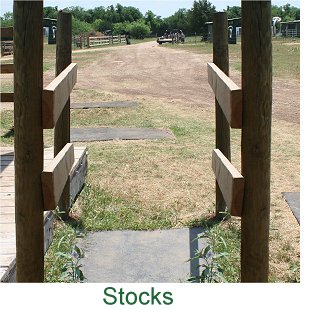 Squeeze
SqueezeWill your horse tolerate a “squeeze” between two objects? Do you have stocks or can you build stocks with four fence posts with 2×6’s on the sides and front so that he learns to walk into the confined space and then back out easily. When that is accomplished, lay a sheet of plywood on the floor of the stocks to simulate the sound of his feet on the ramp or floor of the trailer.
Frequently, once he goes into and out of the plywood-floor stocks routinely, this is enough to start with a trailer.
Progressive Exercises
Suggestion #1.
Small space – Dark Space: I start with taking my horse into any space that is darker and smaller than the outdoors. Do you have a shed or small barn? Walk the horse in, stand in the darkened room until he is quiet, and then back the horse out. (Always back out if that is the way you want him to exit your trailer.) Repeat.
Noise: Practice walking over a piece of plywood. You can lay some plywood down in the pasture and walk over it until the hoof noise is no problem. Move the plywood closer to a small area. If you have a catch pen or stocks, put the plywood in there (as directed above).
Suggestion #2.
If you have a round pen, put the horse in it for 3-4 days. Back the trailer up to it and feed the horse in the trailer – moving the feed progressively forward so that he must first enter with his front feet to reach it and then stretch until he is actually entering with all four.
Some Afterthoughts
Tip #1:
Be particularly vigilant to notice when he is in a calm state of mind. Reward that state of mind with some rest.
Tip #2:
You may find it easier if you bring a calm, easy-loading horse with you to the loading area – a pasture-mate with the right attitude. Take the loading horse in and out of the trailer with ease. Sometimes your horse will load WITH the other horse already loaded.
Tip #3:
If the horse is particularly high-strung or extremely anxious at the sight of the trailer, do some line-lunging work further away from it (find his comfort spot and move closer by a few feet) until you get the horse into a relaxed state of mind at that distance. Move closer to the trailer in baby steps. Wait until he is in a relaxed state again before you make the move closer each time.
Tip #4:
Be careful going into the trailer as the horse goes in. In a large trailer, it may be necessary. However, it can be a dangerous place to be if he panics. That is one of the advantages of the line-lunging technique of loading. He self-loads without your body between him and the walls.
Tip #5:
It is better to have grain at the front of the trailer as a REWARD when he has accomplished the load than it is to use it as a BRIBE to entice him up the ramp and into the space. It rarely works as an enticement.
Clicker training? This is a good exercise for clicker training, shaping his load from approach – to touch – to step – to load.
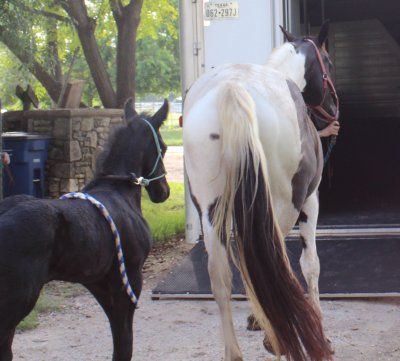 This 9-day old baby is learning to load from the get-go. His Mom is being taken for a Foal-Heat Breeding, and he is learning from her how to load into the trailer.
This 9-day old baby is learning to load from the get-go. His Mom is being taken for a Foal-Heat Breeding, and he is learning from her how to load into the trailer.
The Best Trailer Loading in the World
Below is the best trailer-loading video in the world. Our horses should all be so good. Don’t be fooled. These horse have not been beat by the whip. No horse comes TO an instrument of torture. They have been rewarded by the sound of the whip – perhaps as in “clicker” training with the whip instead of the clicker? Russell Higgins is a Parelli instructor.Horse training and equestrian activities in general can be dangerous. While we try to present relevant and valuable content, under no circumstances does horse-pros.com or its members or contributors take any responsibility for the well-being of any horse or person using a method outlined here.
We certainly don’ t know everything. Please share your expertise and experiences. Comment on what is already written or Suggest a Category and Educate us about it. Grow Horse-Pros.com©

In addition to useful tips on loading a horse into a trailer, I learned a lot of new information. It was a discovery for me that the horse’s eyes perceive light differently. I didn’t even think about it. It was interesting and informative, thank you!
My daughter has a little horse that she’s owned for the past few months, and we’re hoping to buy a trailer for it. We need to get one that it’d fit in even when it grows. I’ll have to make sure that there’s good ventilation throughout it. Maybe my husband can go with me to take a look at some within the next few days.
Most trailers come in fairly standard sizes to fit an adult horse. Some, however, are much taller to fit very tall horsees such as our Friesian and Friesian-cross horses. Unless you have an exceptionally tall horse, an extra tall trailer is not necessary and is an added expense. Good ventilation is, of course, a must. Extra features such as a drop-down ramp, extra padding, and a tack storage area are all nice but also add to the expense. IT is nice to have a padded upper door casing where the horse enters and exits. Check the floor boards VERY carefully for rot! That is the part of the trailer that is the most dangerous if it is not well-maintained.